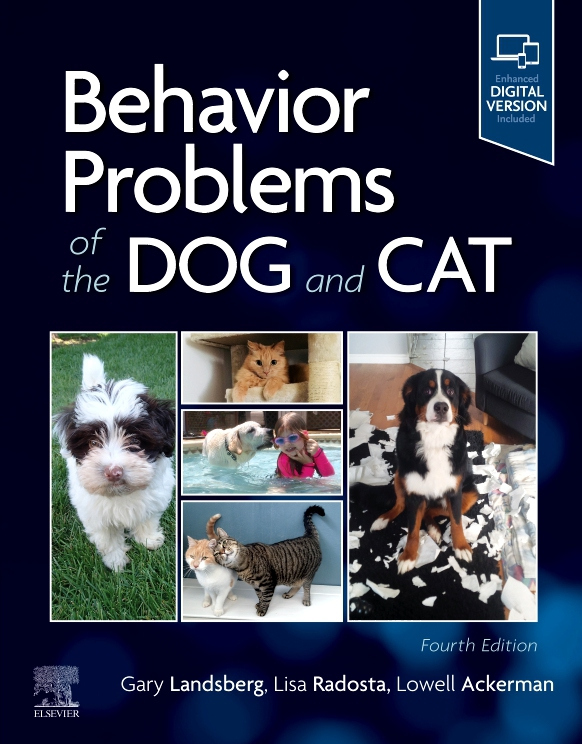
By Gary Landsberg, Wayne Hunthausen and Lowell Ackerman
Behavior Problems of the Dog and Cat 4th Edition retains the highly practical approach that has proved so successful in previous editions, offering diagnostic guidelines, preventive advice, treatment guidelines and charts, case examples, client forms and handouts, and product and resource suggestions, along with details on the use of drugs and natural supplements to help optimize the behavior services offered in practice.

Features
Behavior Problems of the Dog and Cat Features:
- Step-by-step guidelines describe how to collect a patient history, perform a thorough physical examination, conduct diagnostic testing, formulate differential diagnoses, select treatment, and monitor the patients’ responses.
- Background information describes how dog and cat behavior problems arise and how they can be prevented.
- Coverage of behavior modification techniques provides you with a clear understanding of suggested treatment as well as the use of drugs, products, pheromones, surgery, diet, and alternative therapies.
- Content on behavioral genetics explores this rapidly growing and advancing field and includes new therapeutic approaches for cognitive decline.
- Case studies illustrate real-life clinical situations.
- Easy-access treatment tables provide at-a-glance solutions to common behavior problems.
- Useful appendices include treatment protocols as well as the drug information and dosages that make effective prescribing easy.
- NEW! Many hot new topics are covered, including fear, anxiety, and stress and their effects on health and behavior, as well as pain and behavior, the psychobiological approach to veterinary behavior assessment, and pets and the family dynamic.
- NEW! Updated chapter content is extensively augmented or completely rewritten by new authors, making this more than just a new edition – it’s a new book!
- NEW! eBook version is included with print purchase which allows access to all of the text, figures, and references, with the ability to search, customize content, make notes and highlights, and have content read aloud. Online access also includes handouts and forms, drug dosing, and a comprehensive directory of resources.
Table of Contents
- Behavioral medicine and the general practitioner
- Developmental, social, and communicative behavior
- Pet selection and the genetics of behavior
- Pets and the family dynamic
- Prevention: the best medicine
- All body systems affect behavior
- Physiologic stress and its effect on health and welfare
- The effects of aging on behavior in senior pets
- Approach to the diagnosis and treatment
- Behavioral treatment techniques, behavior modification, and learning theory
- Pharmacologic intervention in behavioral therapy
- Treatment – integrative medicine
- Feeding and diet-related problems
- Fears, phobias, and anxiety disorders
- Noise aversion
- Reducing fear, anxiety, and stress in veterinary clinics
- Separation-related disorders
- Abnormal repetitive behaviors: stereotypies and compulsive disorders
- Unruly and destructive behaviors – canine
- Unruly and destructive behaviors – feline
- House soiling – Canine
- House soiling – feline
- Canine aggression
- Feline aggression
- The psychobiological approach to problem behavior assessment
- Appendix A – Behavior resources
Appendix B – Medication dosages
Appendix C – Resources available from book website
Appendix D – This appendix contains forms and handouts that are available online in printable format.
- Index








![Ettinger’s Textbook of Veterinary Internal Medicine 9th Edition [PDF+Videos] Ettinger’s Textbook of Veterinary Internal Medicine 9th Edition [True PDF+Videos]](https://www.vet-ebooks.com/wp-content/uploads/2024/10/ettingers-textbook-of-veterinary-internal-medicine-9th-edition-235x300.jpg)






![Textbook of Veterinary Diagnostic Radiology 8th Edition [PDF+Videos+Quizzes] Thrall’s Textbook of Veterinary Diagnostic Radiology, 8th edition PDF](https://www.vet-ebooks.com/wp-content/uploads/2019/09/textbook-of-veterinary-diagnostic-radiology-8th-edition-100x70.jpg)



![Ettinger’s Textbook of Veterinary Internal Medicine 9th Edition [PDF+Videos] Ettinger’s Textbook of Veterinary Internal Medicine 9th Edition [True PDF+Videos]](https://www.vet-ebooks.com/wp-content/uploads/2024/10/ettingers-textbook-of-veterinary-internal-medicine-9th-edition-100x70.jpg)





